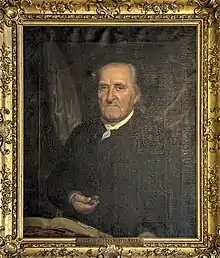Philip William Otterbein
Philip William Otterbein (June 3, 1726 – November 17, 1813) was a U.S. (German-born) clergyman. He was the founder of the United Brethren in Christ, a group which was a forerunner of today's United Methodist Church.

| Part of a series on the |
| Evangelical United Brethren |
|---|
| Background |
| Doctrinal distinctives |
| People |
|
| Predecessor groups |
| Related movements |
Biography
Philip William Otterbein was born in Dillenburg (near Wiesbaden), Germany, into a family that included many clergy. He attended the Reformed seminary at Herborn and was ordained June 13, 1749. He volunteered for missionary work in Pennsylvania, and arrived in New York on July 27, 1752. He served several German speaking parishes near the Pennsylvania-Maryland border, finally moving to the Second Evangelical Reformed Church in Baltimore, where he was pastor from 1774 until his death in 1813.[1] The building where Otterbein preached is still used for worship, and the congregation is now called Old Otterbein United Methodist Church. It is located in the Otterbein neighborhood of Baltimore next to the Baltimore convention center, and is close to the baseball field Oriole Park at Camden Yards.[2]
In 1767 or 1768, Otterbein was present at a worship service in Long's Barn near Lancaster, Pennsylvania. Martin Boehm, a Mennonite who had been born in Lancaster, preached, and after the service Otterbein came forward and greeted Boehm with words that became famous in United Brethren tradition: "Wir sind Brüder" (We are brothers). From that day forward they had a close working relationship. Norwood comments that "They were an interesting pair: Otterbein the stately university-trained minister and Boehm the Mennonite farmer with a full beard." A few years later Boehm was excommunicated by the Mennonites.[3]
By 1773 Otterbein was organizing religious classes on the Wesleyan model, and on the day he began pastoral duties in Baltimore, May 4, 1774, he met Francis Asbury who would be his friend throughout the remainder of his life. Asbury asked Otterbein to be one of four clergy who would lay hands on him when Asbury was ordained (or consecrated) as Methodist bishop, December 27, 1784, when the Methodist Episcopal Church was officially organized.[4] Otterbein died on Wednesday, November 17, 1813. His funeral took place on Saturday, the 20th; the funeral sermon was preached by Rev. J. D. Kurtz in German and delivered in English translation by William Ryland, who would later serve several terms as Chaplain of the Senate.[5] In a memorial sermon in that same year, Asbury called him "the great, the holy Otterbein".[6]
Officially, Otterbein remained in good standing as a German Reformed clergyman until his death, but his work led inexorably to the formation of a new Protestant denomination, the Church of the United Brethren in Christ. In 1798 Otterbein called a conference of clergy, including Boehm, to be held at Otterbein's Baltimore church. They took the first steps toward organizing the denomination. Two years later, in 1800, another conference took more organizational steps,[7] including the decision to use a German translation of the Methodist Episcopal book of discipline. In their conversations those present used words such as "society," "association," and "fellowship," but not the word "church." They began formally calling themselves a "church" in 1814, after Otterbein's death.[8]
In spite of his reluctance to form a church, the younger men in his movement began conducting themselves as if they were clergy, including administration of sacraments, so seven weeks before his death, Otterbein ordained three of his workers: Christian Newcomer, Joseph Hoffman, and Frederick Schaffer.[9] Newcomer was elected bishop after Otterbein's death.[10]
On April 19, 1762, Otterbein married Susan Le Roy of Lancaster, who died April 22, 1768. He suffered great grief because of his wife's death, and he never married again.[11]
Augustus W. Drury wrote the biography of Otterbein in 1884.[12]
Otterbein University in Westerville, Ohio, founded in 1847, is named after Philip William Otterbein.
See also
- List of Methodist Bishops
References
- Malone, Dumas (Ed.). Dictionary of American Biography, Vol. VII, Part 2: Mills-Planter. New York: Charles Scribner's Sons, 1934. pp.107-108.
- http://www.oldotterbeinumc.org/
- Norwood, Frederick A. The Story of American Methodism. Nashville: Abingdon Press, 1974, p. 105-106.
- Malone, op.cit., p. 108, Norwood, op.cit., p. 106.
- Our Bishops: A Sketch of the Origin and Growth of the Church of the United Brethren, by Henry Adams Thompson, p. 70
- Hyde, A. B. The Story of Methodism: The Story in America [part II]. Greenfield, Mass: Willey & Co., 1887, p. 139.
- The McGraw-Hill Encyclopedia of World Biography, Vol. 8, 1973, p. 232.
- Norwood, op. cit., p. 107.
- Malone, op. cit., p. 108.
- Norwood, op.cit., p. 108.
- Malone, op. cit., p. 108.
- Drury, Augustus W. The Life of Rev. Philip William Otterbein, Dayton, Ohio, 1884, republished by The Minerva Group, Inc., 2000. The biography is also included in History of the Church of the United Brethren in Christ, Dayton, Ohio, 1924.